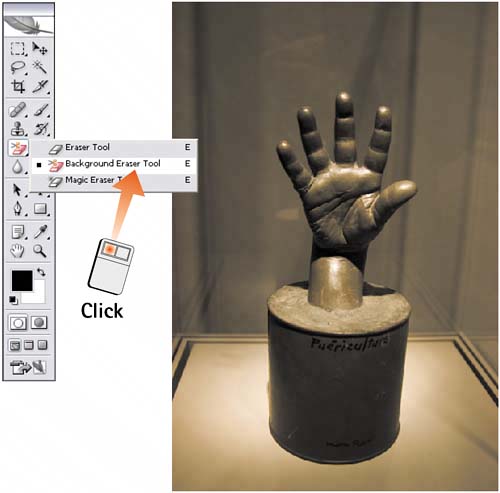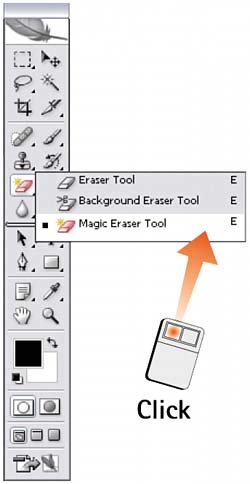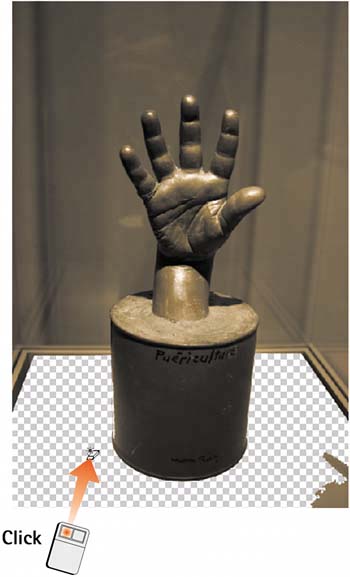Task 3 How to Erase a Background
| Photoshop offers two ways to erase a background: the Background Eraser and the Magic Eraser. This task looks at how to use both tools, highlighting the differences between them. The Background Eraser erases an image area selectively, based on a pixel's value. It remembers the first pixel value you click and then erases only that value, ignoring other values. This initial value is referred to as a sample point because the value of the pixel is used as a sample to determine how the eraser interacts with the image. You use the Tolerance slider to determine whether the brush erases the exact value sampled or a range of values based on the sample. 1. Select Background EraserWith the image you want to modify open onscreen, select the Background Eraser from the toolbox. If necessary, click and hold the active Eraser tool and drag to select the Background Eraser from the pop-out menu that appears.
2. Protect Foreground ColorYou can protect a specified image color from being erased, making it easier to delete the background. To do this, select the Eyedropper tool and sample the color you want to "protect." With the desired color as the current foreground color, enable the Protect Foreground Color check box in the Options bar.  3. Specify Eraser OptionsFrom the Limits menu in the Options bar, select the Find Edges option. This option erases adjacent pixels while maintaining strong edgesthe perfect choice for eliminating the area behind the hand sculpture. The Contiguous and Discontiguous options do not keep as crisp an edge as Find Edges, and they do not work as well for this image.  4. Estimate the Tolerance SettingAlways start with a low Tolerance value and increase as you erase to keep a crisp edge to the image. The higher the Tolerance setting, the more the tool erases. If there is high contrast between the background and object, set the Tolerance slider to a higher setting. The result will be a fast and clean erasure with a crisp edge. If the background and object are similar in contrast, use a low Tolerance setting and erase the area several times, perhaps using a smaller brush. Each image is unique, so you'll have to experiment to find the right settings. To set the tolerance, drag the Tolerance slider in the Options bar.  5. Set the Sampling OptionThe Sampling icons offer the choices of Continuous, Once, and Background Swatch. Click the Once icon to sample only the pixels read when you first click the eraser on the image. As you continue to drag the eraser, only the initial pixel value is erased. Click the Continuous icon to sample continuously, allowing you to erase adjacent background areas of different colors. You can cover a wider range of pixels, although you run the risk of erasing the image edge. Click the Background Swatch icon to erase only the active color in the background swatch in the toolbox. With this option, you can select a background color and the eraser erases only that specific color.  6. Erase the BackgroundMove the cursor into the image window and click and drag to erase the background. The exact erasure result depends on the sampling option you chose in step 5.
At this point, let's start over with the same image and use the Magic Eraser instead of the Background Eraser to get the job done. The Magic Eraser eliminates broad areas of the background with a single mouse click, in much the same way that the Magic Wand tool selects broad areas. When you click in the image, the Magic Eraser measures the pixel value you clicked and erases all adjoining pixels as well. For example, if you have a large, flat area of solid color, a single click erases the entire area. In these next steps, you use the Tolerance setting in the Options bar to specify how wide or narrow your erasure range will be. Increase the Tolerance setting to erase the full area in spite of slight variations in pixel values. Decrease the Tolerance setting to erase a narrower range of pixel values. It helps to examine the image carefully and click the "best" spot to select the color you want to erase. 7. Select the Magic EraserSelect the Magic Eraser from the toolbox. If necessary, click and hold the active Eraser tool and select the Magic Eraser from the pop-out menu that appears.
8. Enable the Anti-Alias OptionIn the Options bar, enable the Anti-alias check box to create a smooth erasure edge. Enable the Sample All Layers check box to erase across all visible layers. Enable the Contiguous check box to erase all adjoining pixels; leave the Contiguous option disabled if you want to erase the pixel value wherever it appears in the image.  9. Erase the ImageClick in the image window to erase a range of pixels. If you don't like the result, select Edit, Undo; revise the Tolerance setting; and try again. Continue clicking to delete the desired area.
|
EAN: 2147483647
Pages: 184
- Article 314 Outlet, Device, Pull, and Junction Boxes; Conduit Bodies; Fittings; and Handhole Enclosures
- Article 353 High Density Polyethylene Conduit Type HDPE Conduit
- Article 374 Cellular Metal Floor Raceways
- Example No. D8 Motor Circuit Conductors, Overload Protection, and Short-Circuit and Ground-Fault Protection
- Example No. D9 Feeder Ampacity Determination for Generator Field Control




